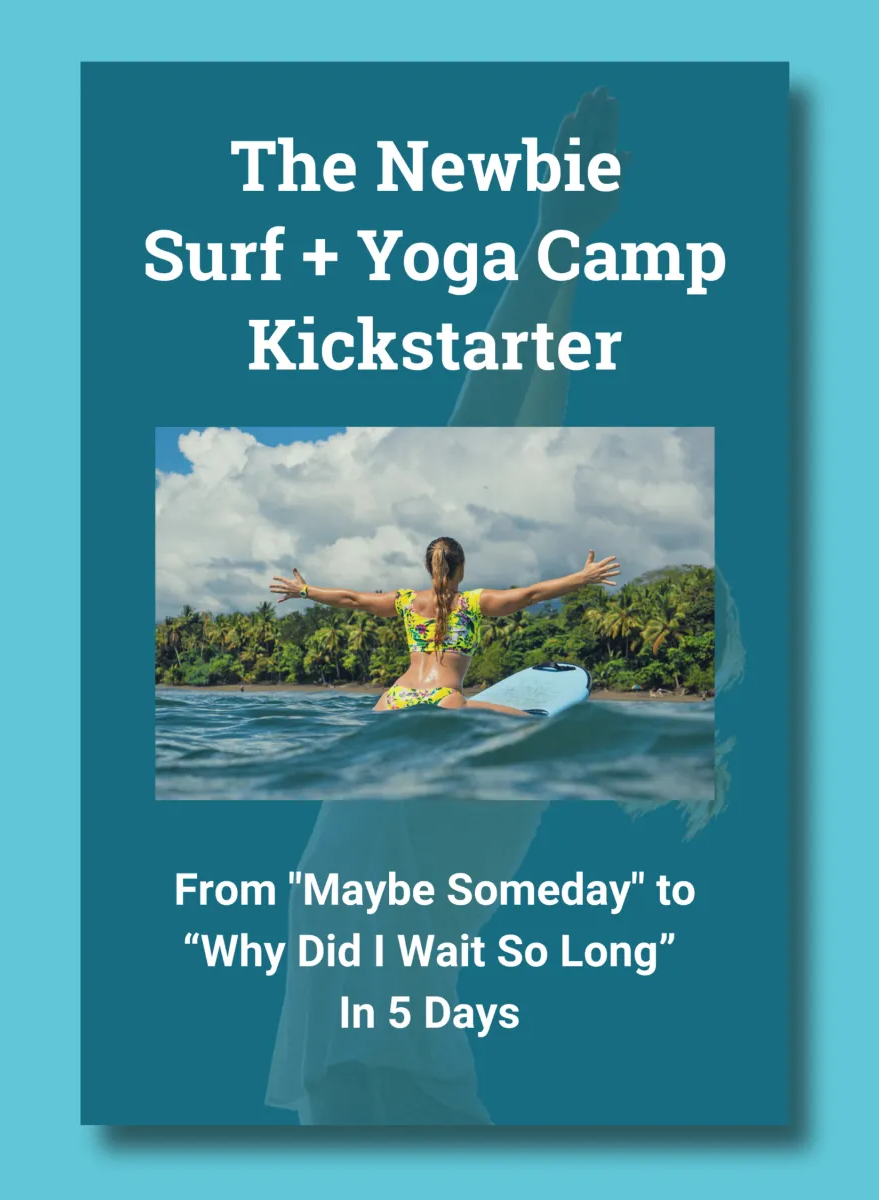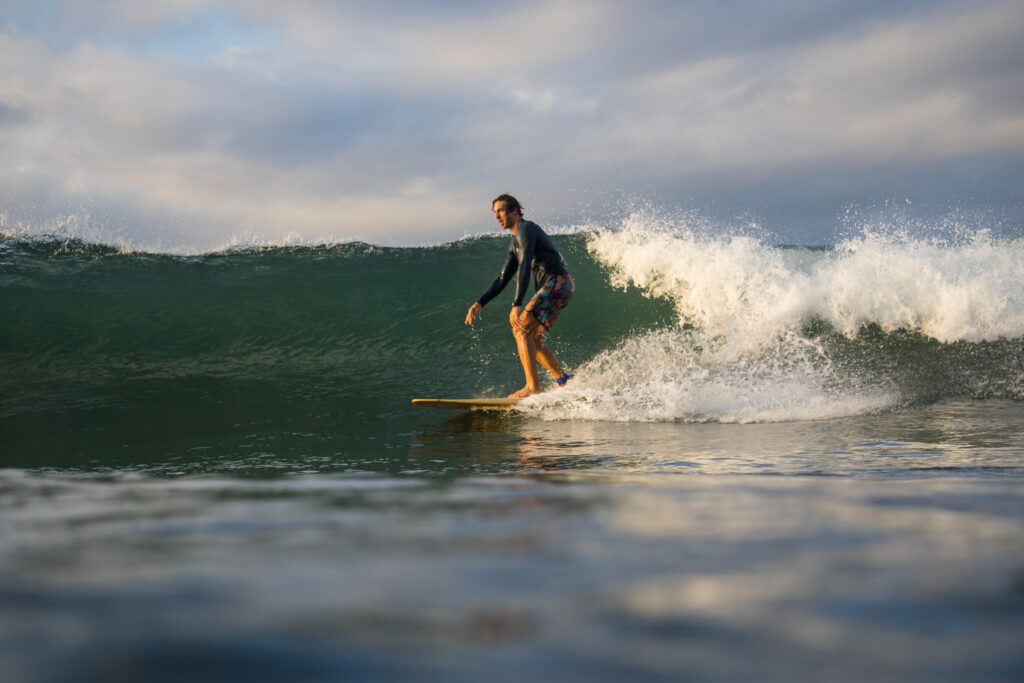Surfboard Control for Beginners: Learning to Surf in the White Water
This is the second installment in our larger Learn to Surf series, which breaks down our entire beginner surf curriculum with video and written lessons.
This post contains lessons two and three of seven. When you’re ready, continue with Lesson 4: How to Pop Up on a Surfboard.
Surfing can be difficult to master without the proper tools and instructions, yet with them, the process is much easier and more enjoyable.
The ability to control one’s surfboard in the controlled environment of the white water zone is an essential skill that all surfers should master before moving out to deeper water and catching their first breaking (green) waves.
Furthermore, each beginner surfer should practice the subtle art of steering the surfboard from the “prone position” (on their belly — similar to boogie boarding) before ever attempting to stand up.
If you are a beginner surfer or even an intermediate surfer who has skipped these vital steps in the learn-to-surf process, then this blog is for you.

Surfboard control for beginners: the skills you need to know
We will cover everything you need to know about surfboard control for beginners as well as catching and riding white water waves from the prone position, including:
- How to walk your surfboard out through the impact (white water) zone
- How to identify a good white water wave for surfing
- How to turn the surfboard around from your feet
- How to position your body on the surfboard
- How to paddle and catch broken waves
- How to avoid nosediving (aka pearling) when catching the wave
- How to speed up, slow down, and bring the board to a stop from the prone position
- How to turn right and left from the prone position
- How to link multiple turns together (aka S-turn) from the prone position
Please note that this blog does not include information about standing up on your surfboard, otherwise known as the “pop-up”. This is because we want you to focus on prone surfing first. Then, you can transition to your feet.
Also, for more on how the different types of surfboard shapes might affect your surfing, read this post here.
We will have a follow-up blog and video to cover the critical next step of popping up.

Why you should learn to surf in the white water first
Surfing is unlike most other sports in that you depend on an ever-changing playing field — the ocean — to produce waves for riding.
Unfortunately, no two ocean waves are exactly alike, especially at a beach break where the seafloor is not a fixed structure, as the sandy bottom moves and changes throughout the day.
Waves are also influenced by shifting factors like the tide, wind, and swell size, which are constantly changing. To learn more about these factors, check out our blog, How to Read a Surf Report.
To become a proficient surfer, you must build muscle memory in a somewhat controlled environment before paddling out to catch your first unbroken waves. Therefore, the white water zone is the best place to simulate a controlled environment and accumulate consistent repetitions.
Don’t worry about standing up on the surfboard just yet. Let’s keep it simple and focus on safety and surfboard control for beginners first.
How to walk your surfboard out through the impact zone
At Bodhi Surf + Yoga, we always instruct our students to walk their surfboards out rather than paddling out. There are several reasons for this. Primarily, we want you to learn how to manage your surfboard and conserve your energy so you can focus on catching and riding waves without burning out too quickly.
Also, it is much safer and easier to walk your board out through the impact zone, so you don’t have to worry about getting swept out by a rip current or getting knocked off your board by the oncoming waves.
If you are walking your board out at a sand-bottom beach break where stingrays are present, then make sure to do the stingray shuffle in shallow water to avoid stepping on a stingray.
- Once you have attached the surf leash to your ankle, walk your board to knee-deep water before setting it flat on the surface.
- If you are right-handed, set the surfboard down on your right side with the nose of the board pointed directly into the oncoming walls of white water. Put the board down on your left side if you are left-handed.
- As you walk your board out to deeper water, place both hands on the back of the board so you can put pressure on the tail and lift the nose to go over oncoming waves.
- Do not back away from the waves as they approach. Keep your momentum moving forward and hit the wave with the surfboard before it hits you. Maintain a firm grip on the back of the board so the waves don’t rip the surfboard out of your hands.
- Spear technique: with your hands firmly placed over the surfboard’s tail, take a step forward at the oncoming wall of white water and push or “spear” the nose of the board through the approaching wave.
How to identify a good white water wave for surfing
Once you have reached stomach-deep water, you are ready to look for a rideable white water wave to catch.
This is one of the hardest things to learn as a beginner surfer: what does a good white water wave look like?
- Look for a bigger wave that has already broken far away from you. The trick is to identify the wave early so you have plenty of time to turn your board around and hop on.
- The wave should look like a “wall” or “ledge” of white water coming in straight across the ocean’s surface.
- Avoid any wave breaking close to you (or right on top of you), as it will probably knock you off your board.

How to turn the surfboard around from your feet
Surfboard control for beginners is an essential skill often overlooked in the learn-to-surf process. Many beginner surfers will pick the surfboard up out of the water to turn it around. This is both dangerous and completely unnecessary. Instead, you want to pivot the board around from the tail.
- As soon as you identify your white water wave, put pressure on the back of the board to lift the nose and create a pivot point under the tail.
- Then, spin your board fully around so the nose of the board is pointing directly at the beach and the tail is squared up with the approaching ledge of whitewater.
- Never place the board between you and the oncoming wave when spinning your board around to the beach. You will spin to the right if the board is on your right side. You will spin to the left if the board is on your left side.

How to position your body on the surfboard
Turn your surfboard around so that the nose is now pointed directly at the beach and the tail is squared up with the oncoming ledge of whitewater. Now you are ready to get on board and start paddling for the wave.
- Step forward, grab the rails, and then pull your chest down to the surfboard deck and swing your feet up over the tail.
- Do not get on from the back of the board and pull yourself forward, as this wastes time and energy. Instead, take a step forward toward the middle of the board and gently place your chest on the deck before swinging your legs up over the tail.
- Your toes should be more or less at the tail of the surfboard with your hips centered directly in between the rails.
- If you’re too far forward on the surfboard, then the nose will start to dive and take on water as you paddle. If you’re too far back, the nose will be up out of the water and it will be impossible to catch the wave.
- Make sure you feel balanced on the board before you start paddling. Try squeezing your knees and feet together while pushing your hips into the board to arch your back and keep your chest up while you paddle.

How to paddle and catch broken waves
Proper paddle technique is an extremely important skill for any surfer to learn. Surfing is mostly paddling, not standing. In fact, the average surfer spends less than 10 percent of any given surf session up on their feet. The rest of the time is spent paddling or sitting and waiting for waves.
- First, it is important to maintain proper paddling posture by squeezing your glutes and engaging your core. This will help you keep your head up without straining your neck.
- As you paddle for the approaching wave, extend one arm out at a time while maintaining a slight bend in the elbow. Try not to flick or splash water as you paddle. Instead, dig the entire forearm underwater with a smooth entry and exit.
- The goal is to create a steady rhythm with your stroke with the chest up and vision forward. Don’t forget to check in with the approaching wave by briefly looking over your shoulder as you paddle.
- It is crucial to keep your board straight while you paddle. Your board should be perpendicular to the oncoming white water ledge so the board’s tail lines up perfectly with the wave.
- Once the wave hits the back of your board, take two more paddle strokes and then bring your hands flat on the board’s deck in line with your rib cage with the elbows tucked in toward your midline (cobra position).
- Smile while you paddle: smiling helps you relax and brings your awareness into the present moment.
How to avoid nosediving (aka pearling) when catching the wave
Nosediving is a very common mistake that almost all beginner surfers repeatedly make when they are trying to catch their first waves. To avoid nosediving, you need to lift your chest up off the board as soon as you catch the wave to prevent the front of the board from diving underwater.
- Basically, you will be transitioning from cobra to updog to prevent the surfboard from pearling as you catch the wave.
- Make sure to keep your hands flat on the deck of the board as you lift up your chest into cobra position. Do not grab the rails of the surfboard.
- Once you have locked out your arms into updog and prevented the board from nosediving, you can bring your chest back down to the deck as you ride straight to the beach.

How to speed up, slow down, and bring the board to a stop (from the prone position)
Just to reiterate, you should spend plenty of time learning how to ride the surfboard on your stomach (prone position) before attempting to stand to your feet. This promotes optimal surfboard control for beginner surfers.
When riding the board straight to the beach in the prone position, you should maintain either a cobra or updog posture until you are ready to bring the board to a stop in shallow water.
- Speed management: There are two main “buttons” on the surfboard that can speed up and slow down. The accelerator button is located in the front half of the board, while the brake button is located in the back half. You can experiment with shifting your weight over each button by lifting your chest up (updog) to slow down and lowering your chest back down (cobra) to speed up.
- When you are ready to bring the board to a stop, shift your weight over the board’s tail by pressing back into child’s pose. The front half of the board will lift up out of the water and the board will come to a stop.
- Now you can hop off your board, spin it around, and guide it back out to stomach-deep water to catch another wave.
How to turn right and left from the prone position
Turning a large surfboard can be difficult, especially if you haven’t mastered surfboard control. You must know where to shift your weight to make a successful turn. Also, practice turning the board from your stomach before you move on to turning from your feet.
Learning to turn the board from your stomach is crucial for building muscle memory and discovering where the different “turn buttons” are on the board.
- The most important factor in making a successful turn is looking where you want to go. If you want to turn 45 degrees to the right, you must turn your head to the right and project your eyes out before you.
- Never grab the rails when turning from the prone position, and try turning the board with your hands. This is a common mistake that beginners make, leading to a wipeout almost every time. Instead, keep your hands flat on the board’s deck and shift your hips in the direction you are turning.
- When turning the surfboard, you must shift your weight back over the tail where the fins and back rails are located. By shifting your weight back, you create a pivot point over the tail that allows you to maneuver the board where you want to go.
- Once you complete your turn, you must bring your chest back down to the board’s deck to speed back up again. If you keep your chest up and your hips over the back rail, then you will simply turn your board out of the wave and your ride will be over.
How to link multiple turns together (aka the S-turn)
The last and ultimate challenge in surfboard control for beginners, to master before standing up to your feet, is called the S-turn. To complete a full S-turn from the prone position, you will start by turning the board in one direction and then turn it back the other direction on the same wave.
This is quite a challenging task, but once you can perform the S-turn seamlessly, you will have a much deeper understanding of how to turn and control your surfboard.
Here’s your process for completing an S-turn from the prone position:
- Catch the wave
- Bring your hands to the deck of the board in cobra position
- Lift your chest up and lock out your arms
- Look roughly 45 degrees to the right
- Shift your hips over the back right rail
- Wait for the board to turn to the right
- Center your hips and bring your chest back down to the deck
- Press up into a tabletop position
- Shift your hips to the left (to straighten the board out before your next turn)
- Center your hips and bring your chest back down to the deck
- Lift your chest up and lock out your arms
- Look roughly 45 degrees to the left
- Shift your hips over the back left rail
- Wait for the board to turn to the left
Continue to practice the S-turn until you can make smooth, efficient turns from right to left and left to right. Once you’ve mastered the S-turn from the prone position, you will be ready to stand up to your feet!
Above all, remember that learning to control your surfboard in the impact zone and mastering the prone position takes time and patience. Be kind to yourself as you progress on your learn-to-surf journey!
Read the next series installment, How to Pop Up on a Surfboard.

For First-Time Surfers
You Don't Need Experience. You Don't Need Gear. You Just Need This.
Our free 5-day email course that reveals the 5 myths keeping beginners at "I'm not ready" instead of catching their first wave and finding inner peace-and how to overcome them fast.
Change the heading on the Separator tab ->
Search
The Newbie Surf + Yoga Camp Kickstarter
Bust the 5 biggest myths about going to a surf and yoga camp so you can stop procrastinating and start catching waves - with our FREE 5-day email course.
Change the heading on the Separator tab ->
Most Read Blogs
What is the Meaning of Anjali Mudra?
May 27, 2020
Fitness for Surfers: Workouts, Exercises & Training
February 10, 2022
The Best Places to Eat in Uvita, Costa Rica
May 19, 2022
How to Get From SJO to Costa Ballena, Costa Rica
May 31, 2018
Change the heading on the Separator tab ->
Categories
Categories
- Bodysurfing (5)
- Food (8)
- Responsible Business (6)
- Surfing (66)
- Travel (65)
- Yoga (44)
Change the heading on the Separator tab ->
Newsletter
Thanks for subscribing! Please check your email for further instructions.
Change the heading on the Separator tab ->
Follow Us
Bodhi Surf + Yoga
Change the heading on the Separator tab ->
Read more
5 Reasons Why a Surf + Yoga Retreat Should Be Your Next Big Bucket List Adventure
Words by Travis
If you’re reading this, chances are you’re experiencing a little restlessness. You’ve scrolled past the passive beach vacations and you know, deep down, that your next trip needs to be different. It…
Small Things That Make A Big Difference to Progressing Your Surfing
Words by Guest Post
Welcome to the first of our three-part series covering the small things that make a big difference to your surfing! You are most likely reading this because you’ve taken some surf lessons…
Sandbars for Surfers: Everything You Need to Know and More
Words by Guest Post
Ever wonder what a sandbar is? When it’s low tide you can see them, but what happens when the ocean covers them? Most surfers may just look at the waves on the…



